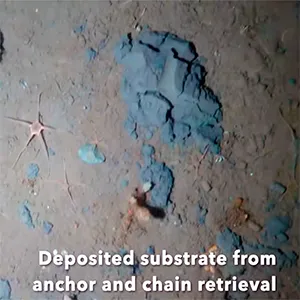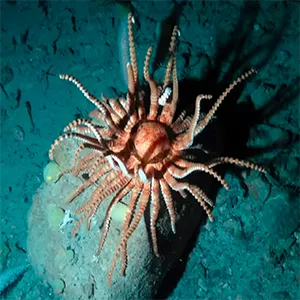
Underwater video shows horrible destruction of Antarctic seabed by ship anchors and chains
Antarctica’s bays look calm from the surface. Down below, that calm hides scars. When large vessels stop in shallow Antarctic waters, many of them still drop heavy anchors attached to long chains.
Wind and currents nudge a ship around, and the chain drags arcs across the bottom. A new study documented what that looks like in Antarctic waters and why it matters for life on the seafloor.
More ships now reach coves along the Antarctic Peninsula and nearby islands during the austral summer.
Sea ice retreats earlier and returns later, so cruise ships, research vessels, and a few private boats visit anchorages that stayed locked in ice in past decades.
That traffic brings people closer to wildlife and science sites, but it also raises a practical question: what happens when anchors and chains meet a slow-growing, cold-water marine community? Short answer: it’s not good.
Anchor damage on Antarctic seafloor
Researchers turned ordinary stops into a survey. They lowered a high-definition camera to hover about 3.3 feet above the seabed.
Over dozens of dives in multiple regions, including well-known locations where ships drop anchor in the icy Antarctic waters, they recorded hours of footage that showed crisp grooves matching the sweep of an anchor chain.
The lens caught bare patches where the top layer of fine sediment had been scraped away and plumes of silt hanging in the water.
In the strongest clips, crushed sponge skeletons and toppled sea fans sat within those chain-swept tracks, while nearby undisturbed patches still supported dense, living communities.
The contrast was clear and immediate: intact habitat next to scraped corridors.

Seafloor damage recovery is slow
Antarctic seafloors host animals that grow slowly in cold, stable water. Many are “sessile,” meaning they stay fixed in place.
Those sponges, fans, and mats of filter feeders add three-dimensional structures that shelter fish and invertebrates and increase local diversity.
Because growth is slow, wounds last. In some temperate seas, anchor scars remain visible for a decade; in Antarctica’s chill, recovery could take far longer.
Flattening these structures does more than change the view. It reduces filtering capacity, shifts which creatures can live there, and lowers the ability of the community to bounce back. These communities also store carbon in tissue and skeletons, so damage can reduce that storage.
Ship tracks tell the story
Icebergs can rake the bottom too, so the team checked that possibility. At several sites, the marks curved and repeated in patterns that fit a swinging chain, not a drifting block of ice. The scars appeared at depths iceberg keels rarely reach.
Small ridges of redeposited mud and smashed but still recognizable sponge structures pointed to recent mechanical scraping. The evidence lined up with anchoring as the cause.
To estimate how often this happens, the team analyzed automatic identification system (AIS) signals – data that ships broadcast to report location and speed – coming from the location of Antarctic anchor drops and chain damage
Clusters of vessels sitting at very low speeds inside sheltered bays strongly suggested anchoring.
In a single busy month at a popular harbor, multiple passenger vessels lingered in depths where standard practice would require paying out five times the water depth in chain.
Even conservative math adds up to hundreds of feet of heavy chain lying on the bottom per ship, with extra sweep as wind and currents shift. Repeated visits concentrate disturbance in the same limited areas.

Study scope and limits
Working in Antarctica means trade-offs. The researchers collected observational evidence rather than running a controlled experiment.
They did not take sediment cores or use laser scales to measure exact dimensions, so they avoided claims about the precise depth of disturbance or the size of damaged organisms.
The combination of high-quality imagery and the behavioral signal from ship movements painted a consistent picture: anchoring in sensitive Antarctic sites is actively harming seafloor life.
Antarctic seafloor anchor solutions
Solutions to combat this problem already exist. Many modern ships can hold position with dynamic positioning – computer-guided thrusters that maintain location without dropping an anchor.
Where anchoring remains necessary, managers can install hardened moorings: permanent anchors connected to floating buoys so vessels can tie off without dragging gear across living habitat.
Harbors can mark “no-anchor” zones around fragile communities and require operators to log and share where they anchor and for how long.
Small choices like these can make a big difference. If a stop will be brief, avoid anchoring. If weather allows, select deeper or less sensitive areas where scouring is less likely to touch vulnerable organisms.
Why does any of this matter?
Those sponge gardens and fan forests filter large volumes of water, trap particles, and create shelter and feeding surfaces for fish, sea stars, brittle stars, sea spiders, and many smaller creatures.
They contribute to local food webs that draw wildlife to the same coves where ships like to pause. When anchors clear-cut living structures, the habitat flattens and becomes less diverse.
Mud suspended by the chain can clog feeding structures, which slows recovery. Glass sponges in these waters can live for centuries to millennia.
A single swing of chain can knock down individuals that took lifetimes to build skeletons. The cost lands on an ecosystem that heals on timescales far longer than a port call.
The study shows vividly what is at stake and how choices at the surface echo across the seafloor. The lesson isn’t “no ships in Antarctica.” The simple solution is “no unnecessary anchors in the wrong places.”
The full study was published in the journal Frontiers in Conservation Science.
—–
Like what you read? Subscribe to our newsletter for engaging articles, exclusive content, and the latest updates.
Check us out on EarthSnap, a free app brought to you by Eric Ralls and Earth.com.
—–













